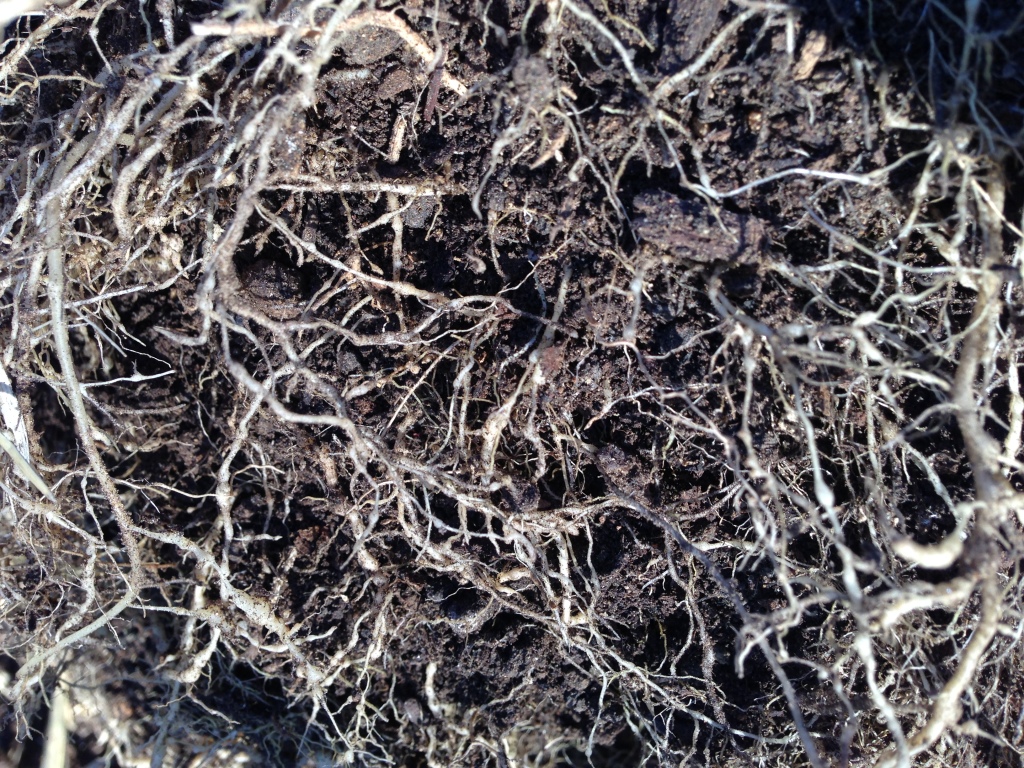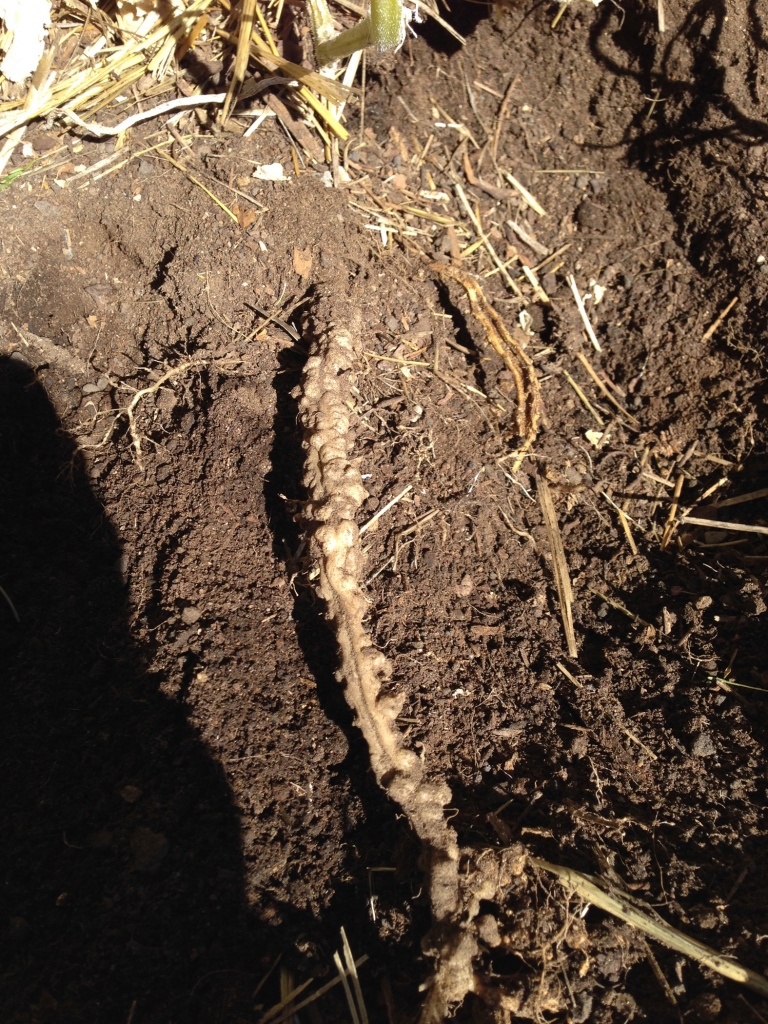

Ambiguous symptoms like wilting and failure to thrive are the most common symptoms of a root-knot nematode infestation. The only way to determine if this is the problem is to inspect the roots for galls or nodes.
A number of other nematode species also can damage home garden and landscape plants including the ring nematode (Criconemoides xenoplax), root lesion nematodes (Pratylenchus species), the sugarbeet cyst nematode (Heterodera schachtii), the citrus nematode (Tylenchulus semipenetrans), the stem and bulb nematode (Ditylenchus dipsaci), and others.
Physical Description
Immature stages and adult males are long, slender worms. Mature adult females of some species such as root knot nematode change to a swollen, pearlike shape, whereas females of other species such as lesion nematode remain slender worms. Nematodes are too small to be seen without a microscope.
Species & Taxonomy
- Kingdom: Animalia
- Phylum: Nematoda
- Class: Secernentea
- Order: Tylenchida
- Family: Meloidogynidae
- Genus Species: Meloidogyne species
Lifecycle
Plant-feeding nematodes go through 6 stages—an egg stage, 4 immature stages, and an adult stage. Many species can develop from egg to egg-laying adult in as little as 21 to 28 days during warm summer months.
Eggs survive in the soil from season to season. After the eggs hatch, the second-stage juveniles invade roots, usually at root tips, causing some of the root cells to enlarge where the nematodes feed and develop. The male nematodes eventually leave the roots, but the females remain embedded, laying their eggs into a jellylike mass that extends through the root surface and into the soil.
Plants Affected
Root knot nematodes attack a wide range of plants, including many common vegetables, fruit trees, and ornamentals.
Plants Unaffected
- These crops are good at reducing root-knot nematode populations:
- Asparagus
- corn
- onions
- garlic
- small grains such as wheat & barley
- sudangrass
- resistant tomato varieties
- resistant bean varieties
- vetch: Cahaba white & Nova
- These plants are usually resistant to root-knot nematodes:
- Crotalaria
- velvet bean
- grasses like rye
Geographical Range
Distributed worldwide; most common in areas of mild winters
Signs & Symptoms
Whole Plant
- stunted growth
- generally unhealthy
- failure to respond normally to fertilizers
- slower-than-normal recovery from wilting
- slow growth, starting early- to mid-season
- symptoms similar to not enough water
Leaves
- wilting in the hottest part of the day, even with adequate moisture
- yellowing leaves
- fewer and smaller leaves produced
- symptoms similar to not enough water
Flowers
Fruit
- unexplained yield reduction
Roots/Tubers
- galls are formed on the roots, making them all gnarly and swollen
- galls are often small, but can get as large as 1″ in diameter
- galls from nematodes can’t be rubbed off, as the beneficial galls formed by nitrogen-fixing bacteria can on legumes
- rough and pimpled and susceptible to cracking
- Carrots typically undergo severe forking with galling predominantly found on lateral roots
- Root-knot nematode galls on lettuce are beadlike
- On grasses and onions, galls are usually small and barely noticeable, often no more than slight swellings
How to Positively Identify
Dig up a plant showing the symptoms and examine the roots for galls. If they cannot be rubbed off, then you’ve got root knot nematodes. If they are small, and can be rubbed off, and it’s a legume, then these are beneficial galls from nitrogen-fixing bacteria.
In garlic, onions, shallots & leeks, if no nodules are present, see Bulb & Stem Nematodes
A simple test can be done to determine if your soil has root knot nematodes: sow some melon seeds in moist soil taken from your suspected garden bed. Keep the pots at about 80 deg F, and in about 3 weeks examine the roots for nodules. If there are nodules, then see treatment plans below, or plant resistant plants or cultivars.
Treatment Plan
- soil solarization: nematodes and their eggs die at 125°F for 30 minutes or 130°F for 5 minutes. Moisten soil then cover with clear plastic and leave in place for 4-6 weeks during the hottest part of the summer. This is a temporary reduction in nematodes, and only for the top 12-inches
Prevention & Control
Nematodes are difficult to control and spread easily from one area to another by moving soil, plants, or from garden tools. On their own, Nematodes migrate through the soil at a rate of 3′ per year, less in heavier, clay soils.
Buying certified, disease-free seed and seed stock, as well as seedlings, is the main way of preventing root knot nematodes from getting into your soil. Also, make sure to get reviews and recommendations before buying compost and soil.
Cultural Controls:
Amendments: Compost, Manure, and Other Organic Matter
- Healthy, biologically-diverse soil is your first line of defense. There are way more non-parasitic (beneficial) nematodes than bad guys, so it’s helpful to encourage nematodes, in general. Routinely adding organic matter (compost & manure) is the best way to encourage good soil biology, and create good soil structure, as well as fertility
- Addition of compost & manure has also been proven to directly decrease the parasitic nematode population, and decrease the damage from the bad guys. This is probably due to the presence nematodes that actually kill the bad guys & eat them. (You can buy these guys to help your fight against the root-knot nematodes from nurseries. More info on this approach down in Natural Enemies & Biological Controls”) There are also nemato-toxins, fungi, and bacteria, as well as other nematode-antagonistic agents present in compost.
- Some sources of organic matter that are known to be good for suppressing parasitic nematodes are:
- oilcakes
- sawdust
- sugarcane bagasse
- bone meal
- horn meal
- compost (compost manure before adding to your soil to kill any nematodes that may be present)
- certain green manures
- Brassicas (broccoli, cabbage, mustards, etc) have a nematode-suppressive effect when the plants decompose
- chitinous materials (crushed shells of shrimp, crab, etc) help by attracting several species of fungi that feed on this chitin. Chitin is in nematodes and their eggs, so they get eaten too.
Cultivation Practices:
General:
- clean soil from gloves and gardening tools before moving to next area in the garden
- make sure to remove the root balls of infected plants
- it’s a good idea to check the roots of all your annual plants as you are removing them for the season, to check for nematode infections, or if you know you have them, to monitor movement in the soil
Weeding:
Tillage:
- Make sure to clean equipment before and after using, to avoid moving parasitic nematodes from one bed or field to another
- Tillage can make root-knot nematode infestations worse, so avoid tilling if you have a known population of the parasitic nematodes
Crop Rotation
- Crop rotation can prevent root-knot nematodes from getting to damaging levels
- Rotation crops that are good for reducing root-knot nematode populations are:
- Asparagus
- corn
- onions
- garlic
- small grains
- vetch: Cahaba white & Nova
- As a general rule, rotate to crops that are not related to each other
- The best rotations include a nematode-suppressive winter cover crop
Cover Crops
- Use nematode-suppressive crops, such as mustards, as a winter cover crop
- Marigolds
- are often talked about as being nematode-suppressive; however, they need to be grown in high numbers, for a full season, to get these benefits. They work by attracting nematodes to their roots, then killing the nematode by ozone that is released.
- Certain marigolds, Tagetes species, suppress root knot and lesion nematodes. French marigolds (varieties include Nemagold, Petite Blanc, Queen Sophia, and Tangerine) are most effective. Avoid signet marigolds, T. signata or tenuifolia, because nematodes will feed and reproduce on these. Marigolds don’t work well against the northern root knot nematode, Meloidogyne hapla, a species common in areas with cool winters. The effect of marigolds is greatest when you grow them as a solid planting for an entire season. When grown along with annual vegetables or beneath trees or vines (intercropping), nematode control usually isn’t very good. To prevent marigold seed from getting in the soil, cut or mow the plants before the flowers open. As with other cultural control methods, nematode populations rapidly will increase as soon as you grow susceptible crops again (UC Davis IPM)
Soil Solarization
While only effective in the top 12″ of soil, solarizing the soil will allow you to grow shallow-rooted annual crops, or start young woody plants which can get established before the nematodes get get to damaging populations. However, this isn’t a good option for perennial crops such as fruit trees, vines, and woody ornamental plants.
Root knot nematodes, and their eggs, die at soil temperatures of 125°F for 30 minutes or 130°F for 5 minutes.
Fallowing
Fallowing for 1 year will decrease nematode populations enough to successfully grow a susceptible annual crop. Two years is even better. Make sure to keep irrigating the bed, though, so nematode eggs hatch, and you have to make sure to control the weeds that nematodes eat. The idea is to starve them so they can’t survive or reproduce. If you get nematode damage the next time you plant a susceptible crop, you will need to repeat fallowing, since they only need a single season to get up to damaging numbers.
Natural Enemies & Biological Controls
Microorganisms:
- Rhizobacteria & Mycorrhizae may help your plants resist root infection by nematodes, as well as some foliar diseases.
- Root-knot nematodes (Meloidogyne spp.) can be controlled with fungal or bacterial biocontrol agents like Paecilomyces lilacinus & Pasteuria penetrans
- There are many kinds of nematophagous (nematode-feeding) fungi. Some fungi use mycelial traps or sticky spores to capture nematodes (Figures 25, 26), for example, Arthrobotrys spp. and Monacrosporium spp. Other fungi parasitize eggs and root-knot nematode females, e.g., Pochonia chlamydosporia and Paecilomyces lilacinus
- The major bacterial antagonists are Pasteuria penetrans and species of Bacillus. Endospores of P. penetrans attach to the cuticle of a juvenile nematode, produce penetration structures that enter the nematode, and slowly consume it. Several nematode antagonists have been studied in both greenhouse and field experiments
- A number of commercial products based on biocontrol agents are available for the management of root-knot and other nematodes